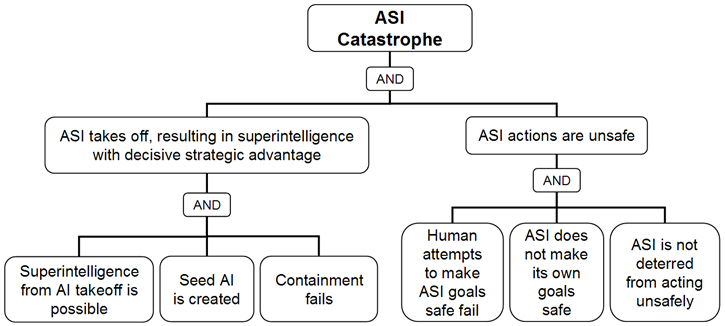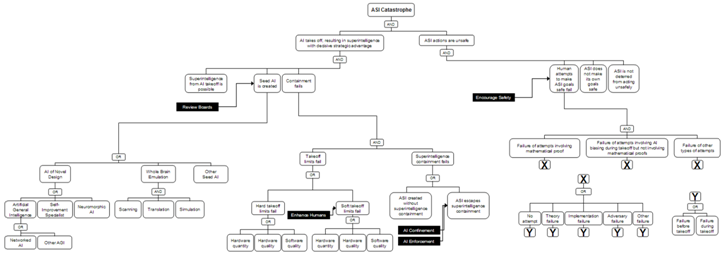
The two main sections of the ASI-PATH model. The “AND” blocks signify that all these criteria must hold for ASI catastrophe to occur. Details are explained in the “The Main Model Sections” paragraph above.
Introduces the ASI-PATH model of catastrophe from recursively self-improving AI.
Anthony M. Barrett and Seth D. Baum, 2017. A model of pathways to artificial superintelligence catastrophe for risk and decision analysis. Journal of Experimental & Theoretical Artificial Intelligence, vol. 29, no. 2, pages 397-414.
Pre-print: Click here to view a full pre-print of the article (pdf).
* Work on this paper was funded in part by a grant from the Future of Life Institute.
Abstract:
An artificial superintelligence (ASI) is artificial intelligence that is significantly more intelligent than humans in all respects. While ASI does not currently exist, some scholars propose that it could be created sometime in the future, and furthermore that its creation could cause a severe global catastrophe, possibly even resulting in human extinction. Given the high stakes, it is important to analyze ASI risk and factor the risk into decisions related to ASI research and development. This paper presents a graphical model of major pathways to ASI catastrophe, focusing on ASI created via recursive self-improvement. The model uses the established risk and decision analysis modeling paradigms of fault trees and influence diagrams in order to depict combinations of events and conditions that could lead to AI catastrophe, as well as intervention options that could decrease risks. The events and conditions include select aspects of the ASI itself as well as the human process of ASI research, development, and management. Model structure is derived from published literature on ASI risk. The model offers a foundation for rigorous quantitative evaluation and decision making on the long-term risk of ASI catastrophe.
Non-Technical Summary: pdf version
Background: Self-Improving Artificial Intelligence
This paper analyzes the risk of a catastrophe scenario involving self-improving artificial intelligence. An self-improving AI is one that makes itself smarter and more capable. In this scenario, the self-improvement is recursive, meaning that the improved AI makes an even more improved AI, and so on. This causes a takeoff of successively more intelligent AIs. The result is an artificial superintelligence (ASI), which is an AI that is significantly more intelligent and more capable than humans. In this scenario, the ASI gains control over the world and causes a major global catastrophe, potentially even killing everyone.
ASI-PATH: The ASI Pathways Model
This paper introduces ASI-PATH, a model for analyzing the risk of global catastrophe from self-improving ASI. ASI-PATH is a fault tree model, which is a standard type of model in risk analysis. The model shows different pathways to ASI catastrophe. For example, the ASI could come from a specially designed AI or from an AI based on the human brain. The model connects these pathways together to show how ASI catastrophe could occur. Specific parts of the model can be assigned probabilities in order to estimate the probability of ASI catastrophe. Coming up with probabilities is a task for future research.
The Main Model Sections
The model has two main sections. One section models how the AI gains control of the world. It has three parts: (1) the physical possibility of takeoff resulting in ASI, (2) the creation of a seed AI capable of recursive self-improvement, and (3) the failure of efforts to contain the AI so that it would not gain control of the world. The other section models how the AI uses its control to cause a catastrophe. It also has three parts: (1) the failure of human efforts to make the AI safe, (2) the AI does not make itself safe, and (3) the AI is not deterred from causing catastrophe. The two main model sections are shown in the first figure below.
Risk Reduction Interventions
ASI-PATH models five interventions that could reduce the risk of ASI catastrophe: (1) Review boards to evaluate the riskiness of specific ASI projects and steer them in safer directions; (2) Encourage research into how to make ASI safer, such as by making funding available or creating a culture of safety among AI researchers; (3) Enhance human capabilities so that an AI would not gain control of the world; (4) Confine the AI so that it does not gain control of the world; and (5) Enable some AIs to prevent other AIs from gaining control of the world. Each intervention affects one or more parts of the model. If future research gets probabilities for the model parts, then the effectiveness of each intervention can be estimated.

The two main sections of the ASI-PATH model. The “AND” blocks signify that all these criteria must hold for ASI catastrophe to occur. Details are explained in the “The Main Model Sections” paragraph above.

The full ASI-PATH model as presented in this paper. Details are explained in the paper. Click on the image for a high resolution version.
Created 5 Apr 2016 * Updated 20 Feb 2017